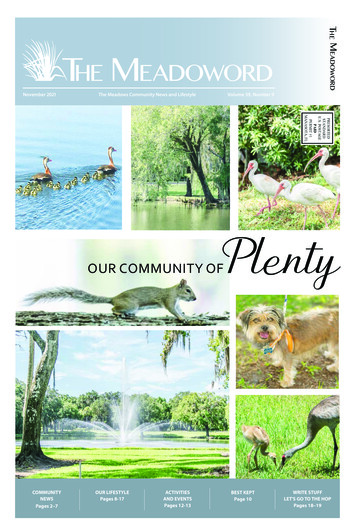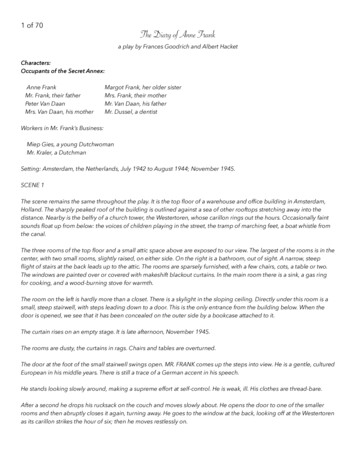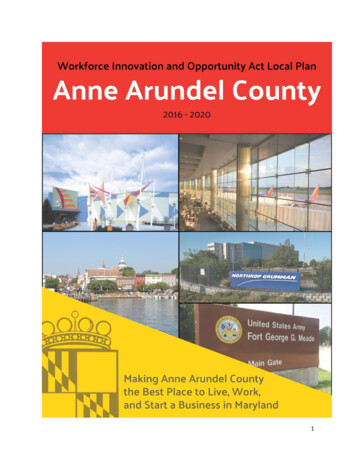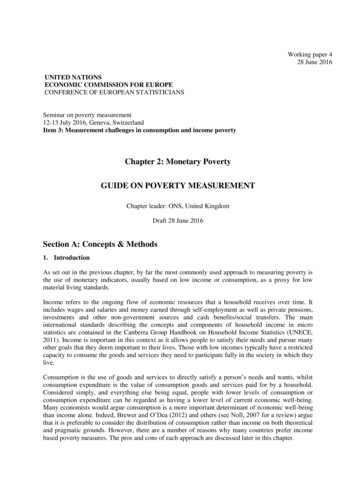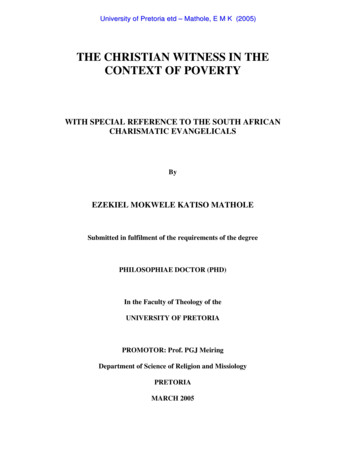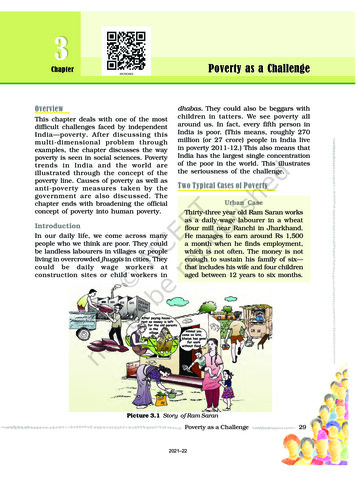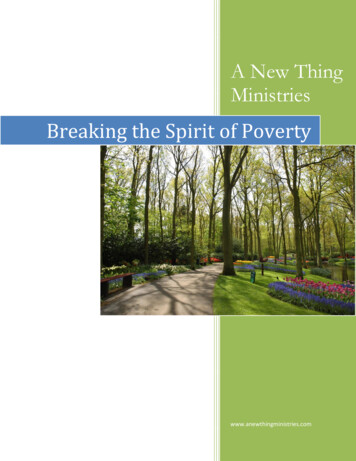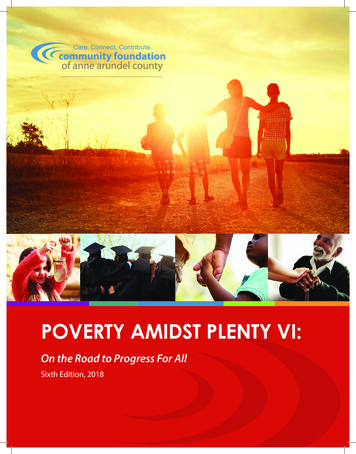
Transcription
POVERTY AMIDST PLENTY VI:On the Road to Progress For AllSixth Edition, 2018
Poverty Amidst Plenty VI. Sixth Edition. Annapolis, MD:Community Foundation of Anne Arundel County 2019.Prepared and written for the Community Foundation of Anne Arundel Countyby Dr. Pamela M. Brown with assistance from Lisa Kovacs, Martha Blaxall and Cindy O’Neill.Copyright Community Foundation of Anne Arundel County, 2019
Table of ContentsChapter 4Forward. 2Summary of Principal Findings. 4Chapter 1Introduction & DemographicsPopulation Demographics. 6Hispanic Community. 7Income. 8Poverty. 9The Environment.12Summary.15Chapter 2Expanding Economic OpportunityEmployment.16Unemployment.17Income Distribution and Poverty.18The Living Wage Model.19The Geography of Poverty.20Transportation.22Affordable Child Care.22Housing.24Homelessness.24Summary.25Chapter 3Youth DevelopmentSchool Readiness.26Mental Health and Behavioral Issues in Early Childhood.27The K-12 Years.28Hispanic Population.29Academic Achievement.29Free and Reduced Meals (FARMS) Students.30Achievement Gap.31Truancy.32Graduations Rates.33Mental Health and Older Youth.34Hungry Children.36Youth Gang Violence.37Homeless/Disconnected Youth.38Sports, Recreation and the Arts.40Career and Work Infant Mortality.44Low Birthweight.45Health Care Access.46Access to Outpatient Care.47Health Professional Shortage Areas.48Medically Underserved Areas.48Hospital Admissions.50The Social Determinants of Health.52Overweight and Obesity.53Access to Healthy Food.54Domestic Violence.55Child Physical and Sexual Abuse.55Sex Trafficking Victims.56Social Media as a Public Health Issue.56Limited English Proficient Residents.57Summary.57Chapter 5Behavioral HealthMental Health.58Access to Care.59The Opioid Epidemic.61Opioid/Heroin Overdoses.62Secondary Victims of the Opioid Crisis.64Other Substance Use.64Summary.65Chapter 6Senior PopulationSenior oral Health.70Transportation.70Kinship & Gaurdianship.71Summary.71Needs Assessment Summary. 72References. 73About CFAAC. 76Acknowledgments. 77Needs Assessment 1
ForwardThe 2018 Anne Arundel County Community Needs Assessment, Poverty Amidst Plenty VI, is the result of an extendedcollaboration between the following partners: The Community Foundation of Anne Arundel County, Anne Arundel MedicalCenter, University of Maryland Baltimore Washington Medical Center, Anne Arundel County Department of Health, Anne ArundelCounty Mental Health Agency, Anne Arundel County Partnership for Children, Youth and Families and the YWCA of Annapolisand Anne Arundel County.The report contains summative (quantitative) data from a variety of local, state and national sources. Population and socioeconomic statistics were compiled using data from the United States (U.S.) Census Bureau’s Population Estimates Programand the American Community Survey 1-Year and 5-Year Estimates. This data should be considered less reliable due to the gapof eight years since the last full census. All data here is based on census estimates. Birth and death data files were obtainedfrom the Maryland Department of Health and Mental Hygiene, Vital Statistics Administration. The emergency department andinpatient hospital discharge data files were obtained from the Maryland Health Services Cost Review Commission for topics likebirth, mortality and hospital utilization. Other data sources used for this report were: Maryland Vital Statistics Annual Reports,Maryland Department of Health and Mental Hygiene’s Annual Cancer Reports, Behavioral Risk Factor Surveillance System(BRFSS), Centers for Disease Control and Prevention’s CDC WONDER Online Database, Centers for Medicare and MedicaidServices, National Vital Statistics Reports and County Health Rankings, and a variety of local databases. The specific data sourcesare listed throughout the report.The report draws on qualitative data gathered from 26 key informants and 11 focus groups. Focus group areas includedemergency department personnel, low income youth, behavioral health providers, Hispanic residents, advocates, domesticviolence victims and a host of others representing a total of 185 participants. The author thanks Lisa Kovacs, AdministrativeCoordinator at the Anne Arundel County Partnership for Children, Youth and Families, for the hours of transcription timespent ensuring this Needs Assessment accurately represents the voices of our community. The data was read and reread untildominant themes emerged which became the subtext of the report. All participants gave permission for their words to be usedin the final report, although their identities are protected. The author would also like to thank Cindy O’Neill and Martha Blaxallfor the hundreds of hours they spent editing and refining this report.ABOUT THE AUTHORDr. Pamela Brown is currently the Executive Director of the Anne Arundel County Partnership for Children, Youth and Families.She completed her Ph.D. in Educational Leadership at Florida Atlantic University. Her dissertation focused on the importanceof community partnerships in diverse neighborhoods. She is a Dissertation Chair for the University of Phoenix specializing inqualitative case study methods. She is certified to conduct ethical research through the Collaborative Institutional TrainingInitiative at the University of Miami. She has been conducting community needs assessments for over 20 years. The author takesfull responsibility for the interpretations and analyses represented here. They do not necessarily represent the interpretations orthe views of the Community Foundation of Anne Arundel County, the Anne Arundel County Partnership for Children, Youth andFamilies, or the staff, boards, officers, or donors of these organizations.2 2018 Needs Assessment
The Community Foundation of Anne Arundel County (CFAAC) is pleased to present the 2018 needs assessment Poverty AmidstPlenty VI to the residents of Anne Arundel County. The purpose of this report is to provide an overview of the issues in AnneArundel County that impact the economy and quality of life. CFAAC is deeply grateful to Dr. Pamela Brown and the Anne ArundelCounty Partnership for Children, Youth, and Families for their extensive work in compiling data and drafting this report.CFAAC’s mission is to connect people who care with causes that matter in our community. The report intends to increaseknowledge and awareness, as well as to frame informed discussions about persistent local trends and needs. This report is alsomeant to inform fund holders, donors, nonprofit grantees, professional adviser partners, and all stakeholders in the county aboutthe challenges facing our community and the importance of their participation in critical conversations focused on transformingand strengthening our community.CFAAC is dedicated to convening both private and public sectors – individual, family and corporate philanthropists, civic and faithbased organizations, nonprofits, community advocates, volunteers, business leaders, elected officials, policymakers, governmentagencies, foundations, professional advisors, and others – to prioritize and develop strategies and implementation plans withmeasurable goals to address the most pressing needs of our community.We believe that by tracking key measures of community well-being, and developing a common vision for Anne Arundel Countysupported by shared commitment and strong leadership, dynamic partnerships across all sectors can be forged to determinereal community solutions. To support these efforts, CFAAC plays an important role by continuing to build a permanent source ofphilanthropic assets to sustain nonprofit agencies and the important work they do.Founded in 1998, CFAAC is the largest institutional funder of nonprofits in Anne Arundel County. With over 14 million dollars inassets, and 2.3 million dollars in grants made in 2018 alone, CFAAC remains committed to providing an increasingly powerfulpool of resources to sustain the kind of impact that strong philanthropic support can achieve in a community.Since the last community needs assessment report done in 2016, the most pressing community needs have remained constant.Affordable housing and child care, quality health care, jobs that pay a living wage, and the availability of transportation continueto be identified as key determinants to a strong and thriving community in Anne Arundel County. Newer concerns haveswept across our county as well, including the increasingly devastating effects on the lives of those impacted by the opioidcrisis. Additionally, the too-close-to-home threat of gun violence has increasingly jumped to the forefront, affecting our entirecommunity, especially in light of the tragic shooting at the Capital Gazette Newspaper office on June 28, 2018. The federal andstate laws associated with the national issue of gun violence, and the political landscape affecting those laws, is beyond thescope of this community needs assessment report. Knowing that Anne Arundel County is engaged with federal, state, and otherlocal authorities in looking at this as a public health issue is an indication of the next steps in the local community, and broader,conversation. Correlations between mental health issues, drug and alcohol abuse, poverty, and increases in gang activity, amongother things, all would seem to play a part in the growing concern over gun violence in our community and in our country.With knowledge comes power, and it is our hope that the information contained in this report sparks powerful conversations andmeaningful progress toward achieving a healthy and strong community for all of the residents of Anne Arundel County.Together we remain steadfast and committed to Achieving Progress for All.James P. NolanChair, Board of TrusteesMary SpencerPresident and CEONeeds Assessment 3
Summary of Principal FindingsPopulation: The Anne Arundel County population has grown 15.3 percent since 2000 to 564,600 residents. Thecounty’s population is aging. Those over the age of 65 have increased since 2014 while the percentages of those19 and under have decreased slightly.Hispanic Population: The Hispanic population is growing more significantly than all other races/ethnicities andis now at 7.3 percent (41,275 residents) of the county’s population. The county has the fourth largest Hispanicpopulation, by percentage, among Maryland counties. The location of the Hispanic population in the county isuneven, with a high of just over 20 percent of the population of the City of Annapolis.Poverty: As of 2018, a family of four (two adults, two children) with an annual income below 25,100 is definedas living in poverty by the federal government. There are roughly 33,000 Anne Arundel County residents (6.1percent) living below the poverty level. There are 31,377 households led by single parents, of which 22,565 havea female as the head of household. Estimates suggest nearly 15 percent of the single parent households in thecounty make an income that is below the federal poverty level.The Income Gap: The gap between rich and poor continues to widen. The number of resident householdswith an income above 200,000 has grown by over 38 percent while the number of households with an incomebelow 25,000 has shrunk, but only by 1.8 percent. The 2018 median household income for the county stood at 99,652; 19 percent more than the state and 65 percent more than the nation.Economic Opportunity: Anne Arundel County is the fifth largest jurisdiction in the state in terms of populationyet it has the third largest economy at 36 billion. There are approximately 15,000 businesses within countyboundaries. The median home price has increased 6.6 percent since 2017 with an average value of 325,333. Theunemployment rate has dropped from almost 7 percent in 2010 to 2.8 percent at the end of 2018.Transportation: The lack of public transportation continues to be a major issue for the county. The majority ofcounty residents (80 percent) drive to work alone in their cars every day; 7.7 percent car pool, two percent walk,and two percent take a bus. There are now five regional transit routes, eight Annapolis routes, four local busroutes, and four commuter bus routes. Additionally, there are two pilot bus routes in South County. Nonetheless,public transportation continued to be a major concern for all participants in this needs assessment. There arelarge areas of the county that are underserved (or not served at all), including North and West County.Housing: As of September 2018, the median home sale price was 345,000, an increase of 10 percent or 30,000 compared to last year. Renters account for 26.4 percent or 52,948 of the 203,336 households in thecounty. Of those renters, 24,172 or 45 percent are overburdened. Renters are considered overburdened whenthey pay more than 30 percent of their gross income in rent. There is a decreasing amount of public andsubsidized housing in the county. There are 10,278 county families on the waiting list for Housing ChoiceVouchers and 17,683 families on the waiting list for public housing. There are 1,514 families on the Annapolispublic housing wait list.Homelessness: Homelessness is a continuing concern for individuals and families in the county. The countyserved 1,684 homeless individuals in 2017. There are still only three homeless shelters in the county and threerapid rehousing programs. In 2018, 1,260 homeless youth were identified in the county public school system.Child Care: Child care continues to be a huge issue for those seeking employment, especially single parents.The average cost of family day care for two children is over 20,000 per year, more for a child care center. Thedistribution of child care centers is uneven across the county. There are none in Brooklyn Park, Harmans orShadyside. The numbers of family day care providers are dropping and that trend is predicted to continueuntil 2022.4 2018 Needs Assessment
Youth Development: There are 127,512 children under the age of 18 living in Anne Arundel County. Of those,35,002 (27.4 percent) are under five years of age, and over 12,0000 (10 percent) live below the federal povertylevel; an increase of two percent since 2015. In 2015, a new kindergarten readiness tool was introduced to Anne Arundel County Public Schools:Ready4Kindergarten or R4K. While scores have slightly improved from a low of 43 percent in 2015, the 2018score of 48 percent shows less than half of county children are ready for kindergarten. In the 2018 Maryland school district rankings, Anne Arundel County ranked 13th of 24 school districts basedon the most recent standardized test scores. Over 80 percent of Anne Arundel County 8th graders are notmeeting standards in math and less than half are meeting standards in reading. There are still gaps in achievement related to race, ethnicity, income, disability, and Limited English Proficientstudents. However, between 2010 and 2016, African American students have shown an 8.56 percentimprovement, and Free and Reduced Meal Students (FARMS) have shown a 7.96 percent improvement ingraduation rates. The county’s chronic truancy or habitual absenteeism rate has risen across all grade levels and studentpopulations. Children from low income families who receive free lunch (FARMS) have the highest levels ofchronic truancy, an increase of three percent since 2014. The overall county unemployment rate for youth ages 17 to 24 stands at 13.6 percent. The rate of youthunemployment for African Americans stands at 25 percent, almost double that of the overall rate.Health: County life expectancy has risen to 79.6 years. In 2017, cardiovascular disease was the leading cause ofdeath followed by cancer. Accidental (unintentional injury) deaths are the fifth leading cause of death, drivenmost likely by increases in opioid overdose deaths. Cardiovascular disease accounted for about 31 percent of allcounty deaths in 2017, an increase of almost 10 percent since 2013.Mental Health: There has been a 70 percent increase in residents seeking mental health services since 2012;16,348 residents were served by the county mental health agency in 2018. The two highest increases in numbersserved are the early childhood population and those over 65. Increased mental health and behavioral issuesin the birth to five early childhood population are causing widespread concern in every system. The county’shospital emergency departments are often the receiving facilities for behavioral health issues. In 2017, therewere 12,446 behavioral health encounters; mood disorders accounted for 26.3 percent of those.Substance Abuse: In 2018, Anne Arundel County police reported almost 1,100 opioid-related overdosesoccurring within the county, a 171 percent increase since 2014. Fentanyl-related deaths in the county haveincreased significantly since 2013 and surpassed heroin related deaths in 2018. The current opioid crisis hasmany victims. The number of newborns assessed positive for substances in their systems, including methadone,has risen 144 percent since 2014 from 74 to 181. Grandparents and great grandparents are raising children withlittle governmental help.The Environment: The annual State of the Bay Report from the Chesapeake Bay Foundation tracks severalindicators detailing the overall health of the Bay. The record precipitation that fell in Maryland in 2018 led to anoverall increase in pollution in the Bay and other waterways. Despite many efforts by federal, state, and localgovernments and other interested parties, pollution in the Bay does not meet existing water quality standards.All of the county’s waterways are considered “impaired” because of excessive levels of major contaminants,which are largely a result of untreated storm water runoff.Social Media: The use of social media, including the active use of smart phones and tablets, is a major concernfor residents and professionals in every area of the county. The constant access to electronic information isimpacting every age group and demographic. Babies as young as 12 months have been observed in the countyholding iPhones and tablets. One early childhood provider described this as “soothing by cell phone”.Needs Assessment 5
Chapter 1 Introduction & DemographicsAnne Arundel County is the fifth largest county in Maryland, covering 415 square miles with 534 miles of natural shoreline. Forthe majority of residents it is a wonderful place to live. Most recent household median income estimates stand at 99,652.1 Theunemployment rate as of December 2018 is 2.8 percent, lower than the state average of 3.4 percent.2 However, there are 33,246 AnneArundel County residents (6.1 percent) living below the poverty level. The rate of poverty for children is much higher at 9.3 percent.Single female head of household numbers are even higher, and there are racial disparities. Nearly 15 percent of White and 20 percent ofAfrican American single female head of households are at or below the poverty level.3 Economic distress is spread unequally throughoutthe county, with pockets of low income and poverty level families clustered in North and South County areas and in Annapolis.In 2018, residents are most concerned about the heroin/opioid crisis, youth gun and gang violence, behavioral issues amongthe very young, and the impact of social media on every facet of our lives and the lives of our children. Participants in this needsassessment agreed that lack of transportation was the most often cited barrier to success in Anne Arundel County. Transportationimpacts all facets of life, from accessing appropriate medical care to acquiring and retaining employment. The lack of quality,affordable child care and affordable housing are continuing barriers for poverty-level and low income families as they try to movetowards self-sufficiency.Population DemographicsThe most recent census estimates on the diversity of the county illustrate a diminishing White, Caucasian population. The Hispanicpopulation has grown 219 percent since the year 2000 (Table 1). The most common foreign languages in Anne Arundel County areSpanish (26,124 speakers), Tagalog (2,810 speakers), and Korean (2,751 speakers). Compared to other places, Anne Arundel County has arelatively high number of individuals who speak Greek (737 speakers), Korean (2,751 speakers), and African languages (2,387 speakers).4Table 1Ethnic/Racial CompositionAnne Arundel County, 2000-201720002010% Change2000-20172017Number%Number%Number%%Total spanic Whites390,51979.8405,45675.4393,13969.60.6Other Races99,13720.2132,20024.6171,19130.372.6Hispanic orLatino12,9022.632,9026.141,2757.3219.9Black Other*20,4804.215,814340,5517.198U.S. Census Bureau, American Community Survey, 2016. “Other” here includes “American Indian and Alaskan Native and “Asian,” “Native Hawaiian or otherPacific Islander,” “Some other race,” or “Two or more races.” Therefore, the “White” and “Black” figures are those who were counted as “White alone” or “Black alone.”1234U.S. Census Bureau, 2013-2017 American Community Survey 5-Year Estimates, 2018.Maryland Department of Labor, Licensing and Regulation, Local Area Unemployment Statistics, 2019.U.S. Census Bureau, American Community Survey 2013-2017 5-year Estimates.Ibid.6 2018 Needs Assessment
Anne Arundel County has an aging population. Since 2014, the percentage of residents over the age of 65 has increased whilethe percentage of residents 19 and under have decreased slightly (Figure 1).Figure 1ANNE ARUNDEL COUNTY AGE DISTRIBUTION(2014-2018)65 0-2920-2910-1910-1971%70%0-90-920182014Anne Arundel County Economic Development Corporation, 2018The Hispanic CommunityWhile the White Caucasian population of the county continues to diminish, the Hispanic population is growing more significantlythan all other races/ethnicities and is now at 7.3 percent, still lower than the state average of 9.8 percent.5 The county has thefourth largest Hispanic population by percentage among Maryland counties. The distribution of the population is uneven in thecounty, with a high of 20.3 percent in the City of Annapolis. The largest sector of the Hispanic population is from Central Americancountries, including a growing population from El Salvador. This is significantly different from the overall U.S. Hispanic population,which is overwhelmingly Mexican (63 percent).6Traditional governmental systems, from the city and county police departments to the public schools and health systems, arestruggling to adequately respond to this growing Spanish-speaking population. Only seven Annapolis City and nine countypolice officers speak Spanish, and only nine percent of full-time civilian personnel speak spanish.7 The public school system has ashortage of teachers for English Language Learners.8 The county mental health agency reports a woeful lack of Spanish-speakingcounselors. There is only one Spanish-speaking psychiatrist in the county.956789Pew Research Center, Hispanic Trends: Anne Arundel County, Maryland, 2016.Flores, Antonio, How the U.S. Hispanic Population is Changing, Pew Research Center, 2017.City of Annapolis Police Department, 2017.Anne Arundel County Public Schools, 2018.Anne Arundel County Mental Health Agency, 2018.Needs Assessment 7
Chapter 1 Introduction & DemographicsCommunity focus group participants in this Needs Assessment noted the following general trends in the Hispanic community: The Hispanic community lives in clusters within the county, in close proximity to public and subsidized housing and low rentprivate accommodations. Many family members live together in overcrowded conditions; some townhouses hold up to fourfamilies. Approximately 90 percent of families are sharing homes. Many Hispanic residents are actively seeking English lessons, but the lack of transportation to the community college or Centrode Ayuda, and the lack of time due to long working hours, are barriers. Children of Hispanic families spend many hours alone as the parent/caregiver often works two or three jobs. School personneland others report that hunger is a problem for some of the children. Several respondents noted the man of the family is rarelypresent in the home. They work seasonal and low paying jobs with long hours. Focus group participants stated that many Hispanic parents are scare
county residents (80 percent) drive to work alone in their cars every day; 7.7 percent car pool, two percent walk, and two percent take a bus. There are now five regional transit routes, eight Annapolis routes, four local bus routes, and four commuter bus routes. Additionally, there are two pilot bus routes in South County. Nonetheless,
